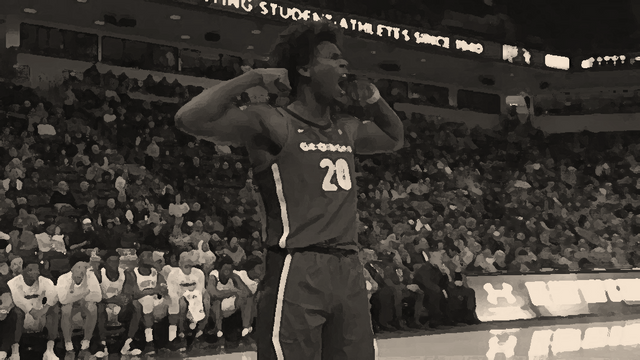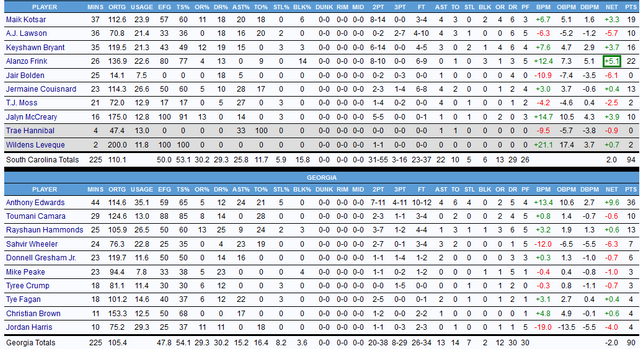
Georgia brought the fight to South Carolina, but South Carolina's brute strength and Georgia's wasted possessions decided the game.
It was an old-school Georgia-South Carolina Basketball game just with a faster pace. The differences between South Carolina and Georgia were made clear by South Carolina's complete domination of the restricted arc and Georgia's heavy reliance on perimeter shooting to stay in the game. Both teams made critical errors late, but Georgia made more mistakes and showed less maturity. A game should not eventually come down to a block/charge call, but it ultimately did in this battle of depth and attrition.
Georgia's tactical mistakes late in the game.
Offensive Calls
In Overtime and late in regulation, Georgia turned to isos rather than running actual offensive sets with movement. This led to a lot of standing around and hoping that Anthony Edwards makes a play, the isos were not working. Edwards had an amazing game, but he struggled in iso situations on offense. Edwards' instincts were also a bit off as the primary ball handler in the Half Court and in transition. Edwards' instincts in a transition situation should be to go straight to the rim, but he ended up committing turnovers when he tried to pass and quick three point shots in transition are de facto turnovers. Edwards' instincts in Half Court is typically to finish it himself off the dribble or create his own jump shot, which is exactly what opponents want him to do. Edwards is not practiced enough and his instincts are not there in iso situations to carry the team. This was a mistake on the part of Tom Crean. The offense had success with ball movement, movement without the ball, and the ball screens. Getting away from this was a huge mistake, which set up South Carolina for more advantageous opportunities.
The other problem with the isos late in the game and also noticeably at the end of the First Half was that the team falls asleep when the objective is to shorten the game. There are two problems: The team is falling asleep and in the situations where the game is being shortened, it simply should not as it goes against the DNA of this team. Iso drives and jump shots result in one of five things happening.
- Missed shot with run out opportunity.
- Missed shot with out of position rebounder committing a foul.
- Charge call.
- Made shot.
- Block call.
It is never a good idea to put the game in the officials' hands and a challenged shot is a bad shot.
The other offensive problem was the overreliance on Anthony Edwards. With everyone waiting on Edwards and the South Carolina defense keyed in on him, it was going to be tough to get the ball into his hands in the first place. Edwards, in Overtime, was running out of gas. He plays a lot of minutes (44 minutes played tonight) and it was clear that Sahvir Wheeler was more suited to being the primary ball handler as he was fresher and faster than anyone on the floor. Waiting for the fatigued Edwards on an inbounds play down 91-88 with 12.7 seconds left cost Georgia precious seconds because the design was specifically geared toward Edwards. Wheeler bailed the team out with a dribble drive, but too much time went off the clock given the deficit.
Edwards' speed, acceleration, and explosion as a driver and ball-handler suffered due to his fatigue and it allowed Jermaine Couisnard to stay in front of him. This is the downside of not playing enough guys and putting the team on Edwards' back like this. It's not an honor, it's a burden.
Not going after Alanzo Frink, A.J. Lawson, and Jermaine Couisnard earlier.
The best designed play of the night was a ball screen that forced Alanzo Frink and Maik Kotsar to switch in man-to-man defense. Who was the ball handler? Rayshaun Hammonds. Putting Frink or Kotsar on Edwards or Wheeler is a recipe for trouble as there would be nobody to guard the interior at all. However, Hammonds drew them both out and forced a foul imperiled Frink to play passive defense against Hammonds' dribble drive. Kotsar could not contain Hammonds and Frink could not play Hammonds tough enough because he would have fouled out. There were not enough of these situations late in the game when South Carolina was racking up fouls. Getting Frink out of the game would have taken away the main interior option for the Gamecocks and the objective would be to turn Maik Kotsar into a driver rather than a mid-range shooter (he is probably the only player in the country who is that good of a mid-range shooter).

What is the difference between Georgia and South Carolina right now? Mental and physical strength.
When analysts talk about size, they are not always talking about height and there is always an assumption that height and ability to rebound are correlated. Much of Georgia's issues in the interior have nothing to do with height, they have to do with the weight room. Alanzo Frink is 6'7" 265 pounds and he was guarded in 3/4 front position by Toumani Camara who is 6'8" 215 pounds, if he decided to gorge himself at Snelling Dining Hall. Camara is taller, but he is far less developed physically. The physiques of the South Carolina players were far more developed than the Georgia players, it was extremely obvious. There was a time when Georgia would be able to bully opponents with superior strength and weight, but those teams played at an extremely slow pace and smaller opponents adjusted accordingly. Georgia has not really adjusted to such disparate differences.
South Carolina was 20/24 in the restricted arc. Georgia was 14/19 in the restricted arc.
South Carolina wore down Georgia physically and mentally.
The inability to guard the strong and explosive trio of Frink, McCreary, and Bryant set the stage for the loss. Frank Martin's frontcourt was able to patrol the interior on the defensive end and the Georgia offense did not move well enough to win. The ball movement decayed as the game was turning into one possession slug fest. South Carolina did not stray from their usual strategy, they kept pounding the inside and ran their Spread Motion Offense with confidence.
This same confidence is not there for Georgia. Crean went to his crutch, Anthony Edwards, far too often and the team fell because of it. Mid-major teams in the NCAA Tournament could go with the Hero Ball approach, but it is never sustainable. Edwards had a valiant effort, but it did not have to be this way.
The decision-making worsened as the game progressed and while Georgia was the team that won the X-Factor points, they could not sustain the shooting performance from the First Half and the team went 2/12 from three point range after the First Half. Most of the three point shot attempts were ill-advised after the First Half.
The Turnover Plague and Rebounding Did Not Cause the Loss
Georgia's turnovers and rebounding was good enough to win, but the following are recurring issues that doom this team and kill momentum.
- Poor shot selection from three point range.
- Unnecessary isos. Save that for the NBA.
- Inconsistent movement without the ball.
- Lack of defensive alertness.
- No effort to slow down or disrupt the opponent on defense after making a basket.
- Not changing up defenses enough (1-2-2 Matchup Zone was effective until the mental lapses started happening)
Current mood: